History of Sculpture in the Český Krumlov Region
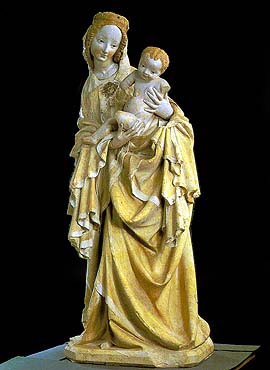 Český Krumlov entered the
development of Central European Gothic sculpture at the peak of a
period of the so-called beautiful style. The famous Madonna of
Krumlov from 1393, that is today placed in the Arts and Crafts
Museum in Vienna, especially represents this style. Although the
most of the sculptures up to that time were imported from the
centre of Praha, the Český Krumlov court that had very high level
of cultural life, established a tradition of a local carving
production and this production reached very high quality in the
following 15th century. The need of such production was also
developed thanks to quite a high number of Marian pilgrimage places
(Vyšší Brod, Zlatá Koruna, Kájov), that were, even at the very
unstable times of the Hussite wars in the 15th century, protected
by the Catholic dominion of the Rosenbergs. (Places
of Pilgrimage in the Český Krumlov Region)
Český Krumlov entered the
development of Central European Gothic sculpture at the peak of a
period of the so-called beautiful style. The famous Madonna of
Krumlov from 1393, that is today placed in the Arts and Crafts
Museum in Vienna, especially represents this style. Although the
most of the sculptures up to that time were imported from the
centre of Praha, the Český Krumlov court that had very high level
of cultural life, established a tradition of a local carving
production and this production reached very high quality in the
following 15th century. The need of such production was also
developed thanks to quite a high number of Marian pilgrimage places
(Vyšší Brod, Zlatá Koruna, Kájov), that were, even at the very
unstable times of the Hussite wars in the 15th century, protected
by the Catholic dominion of the Rosenbergs. (Places
of Pilgrimage in the Český Krumlov Region)
 Until the last quarter of
the 15th century the tradition of the beautiful style, after
enriching some local features, slowly came to its end. A number of
preserved Late Gothic sculptures that came the most probably came
from the Český Krumlov churches, were moved into many of the little
village churches and chapels during the next centuries. Today most
of these works are placed in the collections of the District Museum
of National History in Český Krumlov, many of them are in the
Aleš´s Gallery of South Bohemia in Hluboká nad Vltavou, some of
them are in the National Gallery in Praha. The influences of the
excellent Passau carving workshop of the Master of the altar in
Kefermarnt arrived in our region at the very end of the 15th
century - for example the Madonna at the great altar in the
Kájov Pilgrimage Church which is a reminder of the original
lost great altar. The original great altar was made by the very
active Kájov priest Pils between 1500 - 1503. Beside the Podunajské
influences it is also evident the influence of the carving workshop
of the Master of Mourning over the Death of Christ of Žebrák from
České Budějovice (the sculptures of St. Peter and Paul from Svéráz,
today placed in the District Museum of National History in Český
Krumlov). The superiority of the works connected with the Marian
cult is dominant in the production of sculptures.
Until the last quarter of
the 15th century the tradition of the beautiful style, after
enriching some local features, slowly came to its end. A number of
preserved Late Gothic sculptures that came the most probably came
from the Český Krumlov churches, were moved into many of the little
village churches and chapels during the next centuries. Today most
of these works are placed in the collections of the District Museum
of National History in Český Krumlov, many of them are in the
Aleš´s Gallery of South Bohemia in Hluboká nad Vltavou, some of
them are in the National Gallery in Praha. The influences of the
excellent Passau carving workshop of the Master of the altar in
Kefermarnt arrived in our region at the very end of the 15th
century - for example the Madonna at the great altar in the
Kájov Pilgrimage Church which is a reminder of the original
lost great altar. The original great altar was made by the very
active Kájov priest Pils between 1500 - 1503. Beside the Podunajské
influences it is also evident the influence of the carving workshop
of the Master of Mourning over the Death of Christ of Žebrák from
České Budějovice (the sculptures of St. Peter and Paul from Svéráz,
today placed in the District Museum of National History in Český
Krumlov). The superiority of the works connected with the Marian
cult is dominant in the production of sculptures.
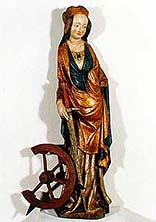
|

|

|
The main reason why the production of stone sculpture, except of
ornamental moulds, was not developing so fast was lack of suitable
stone. The sculptor used only yellowish not very durable granite of
very poor quality taken from smaller quarries located near
Besednice and also from granite boulders found at the slopes of
hills. Unfortunately it was very difficult to work these
stones.
After the battle of Bílá Hora (1620) the Eggenberg period at the end of the 17th century brought vitality to the production of sculptures in Český Krumlov. Some of Masters of carving from Upper Austria who worked in the border-lands on the estates of the Premonstery monastery in Schlgel and the Cistercian monastery in Vyšší Brod - Johann Wrath from Schlgel (decorated some altars of the monastery church of Presentation of the Virgin Mary and Corpus Christi and the great altar in the St. Vitus Church in Český Krumlov) and Philip Rambler from Freistadt (the sculptural decoration of the great organs of the former church of the Zlatá Koruna Monastery from 1698 - 1699) came to the Český Krumlov region. The oldest Baroque stone sculptures of Český Krumlov - St. John the Evangelist and the Holy Virgin under a stone crucifix were made 1691 - 1693. Today they are placed at the court of the former prelature in Český Krumlov (Horní No. 155). Their sculptor - allegedly coming from the people from M. Lindenmayer's group - managed to work through with the expression and the details of the figure very impressively, even if it was difficult to work the granite material. Far from this standard of work is the sculptor - probably a sculptor of Český Krumlov, Josef Pabl - of the granite Bičovaný Kristus (Whipped Christ) and Jidášův polibek (Kiss of Judas) placed in the chapels on the bridge before the Budějovická gate.

|

|
A work of the important Baroque sculptor Matěj Václav
Jäckel on the sculptural decorations of the Marian Column built
in 1716 at the square in Český Krumlov is considered to be a real
breakthrough of the High-Baroque in the Český Krumlov region. The
architecture of the column itself was made by a local stone-cutter
J. Plansker. Jckel himself made the top sculpture of the Immaculate
and another eight sculptures of saints - St. Wenceslas, St. Vitus,
St. John the Evangelist and St. Jude Tadeus in the corners of a
pedestal and St. Rochus, St. Francis Xavier, St. Sebastian and St.
Gaetano in the pedestal niches. (Fountain
in the Square of Český Krumlov). Matěj Václav Jckel also
influenced the work of the most significant sculptor of České
Budějovice Josef Dietrich who also worked in the Český Krumlov
region and sculpted a replica of the famous sculpture of St. Anna,
placed on the Charles´ bridge in Praha, on a bridge in front of the
Vyšší Brod monastery.

|
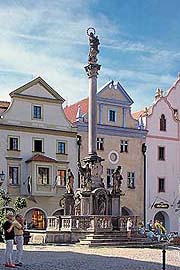
|

|
An expansion of the St. Jan Nepomucký cult in the middle of the
18th century was considerable especially in the border-lands of the
region. At that time several very valuable St. John´s pillars and
sculptural groups were made (Rožmberk nad Vltavou, Benešov nad
Černou, Rožmitál na Šumavě). The Baroque religiousness as well as
the new artistic influences coming through the court of Eggenbergs
and also later on the Schwarzenbergs, were responsible for the
great development of the Late Baroque and Rococo sculptural
production in stone, stucco and wood. A very easily workable
whitish lacustrine limestone began to be imported from the quarries
near Eggenberg in Austria. Český Krumlov became a work place of the
most significant local Late Baroque sculptor Jan Antonín
Zinner who was a student of Josef Dietrich. Four sculptures
placed on the Cloak
Bridge - St. Antonín Paduánský, St. Felix from Kantalicie, St.
Jan Nepomucký and St. Wenceslas - are from his workshop. In
comparison with Dietrich´s sculptures these, made in 1747, are more
static, the bodies are taller and thin, only the faces suggest an
attempt at deeply affected expression. But generally the works do
not surpass the professional standard.

|

|

|

|
A break through in Zinner´s work is a sculptural decoration of the
Cascade
Fountain in the castle park. It is considered as the greatest
sculptural work of the 18th century. The decorations began in 1749
and they were finished with help of the Český Krumlov sculptor
Josef Griesler in 1765. It is difficult to distinguish exactly
which part of work belongs to whom but according to the records
Zinner had to correct some of Griesler´s work, so it is possible
that Griesler made mainly decorative parts (vases, etc.). Detailed
work is pushed a little back by a dynamic playfulness of the single
central sculptural groups that were designed by Andreas
Altomonte. He was inspired by similar work abroad. As a whole
the cascade fountain with its dynamic and close composition of the
sculptures placed in a small space is much more impressive than for
example a similar fountain near Belveder in Vienna. The decoration
of this fountain is spread into larger space.
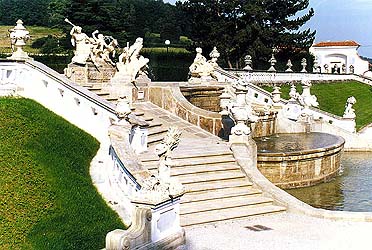
|

|
It is possible to see some similar tendencies on much simpler
sculptures such as the Holy Virgin and St. Joseph placed on a
bridge above the Bear
Moat at Český Krumlov Castle - and especially the sculpture of
St. Joseph with quite daring design of the sculpture of the Infant
Jesus by his foot. It is recognisable that its sculptor, who is
identical to the sculptor of the cascade fountain, did have a
chance to meet the most impressive works of his time in
neighbouring Austria, probably thanks to the court of the
Schwarzenbergs. For completeness it is necessary to mention the
stucco work of Mathias André in Český Krumlov castle.
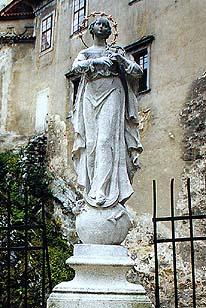
|

|
The promising increase of the sculptural production in the Český
Krumlov region dropped again in the last third of the 18th century.
Matěj Grisler, whose work did not reach the standard of Zinner´s
work, died in 1773 and after his death no significant personality
worked in sculpture in Český Krumlov. The sculptors and artists
from the neighbouring regions are chosen to do more complicated
works and only the tradition of stonemasonry is still alive in the
Český Krumlov region.
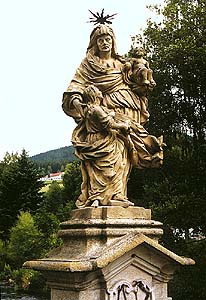
|
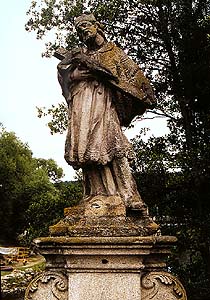
|
(vhon)
Further information:
History
of Sculpture in Český Krumlov
Castle
Lapidarium in Český Krumlov


